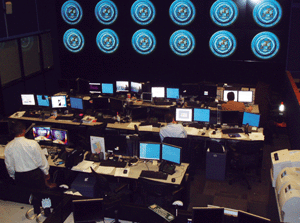Tech Success: New York fights crime with super help desk

When New York City detectives respond to a homicide, any piece of information can be critical to solving the crime. And not only do detectives rely on the information, they need it fast.
When New York City detectives respond to a homicide, any piece of information can be critical to solving the crime. And not only do detectives rely on the information, they need it fast.Quickly providing police with essential data is the goal of the city's new Real Time Crime Center, said Jim Onalfo, New York City Police Department's chief information officer.The crime center staff uses a Web-based system to access records and information, such as 911 calls and arrest records, to assist detectives in the field with investigations. The center also has a two-story video system that can display information, maps and other data."Before the crime center opening, when a detective went to a crime scene, he had very little information from our files that might relate to that area and particular crime," Onalfo said. "Today, when he goes to a crime scene, we'll be able to give him all the information we have about that area: what crimes have taken place there, what types of crimes, what kind of lascivious parolees might be in the area. Anything to help them get a jump-start on trying to sort through a particular crime."The main goal of the project was to get the data quickly and easily, said David Petri, a program manager for systems integrator Dimension Data Inc. at the company's U.S. headquarters in Hauppauge, N.Y.The challenge for NYPD officials was that each area of the department's data -- warrant records, complaint records, arrests information, 911 call records -- was isolated in a separate system."Detectives would literally have to log into each one of those systems to get the information," Petri said. "And the detectives themselves had to know which system had which data, as well as knowing all the nuances of each particular system."Police were spending time negotiating the IT rather than using it to focus on detective work. Often, detectives would have to return to a precinct house hours or days after the crime was committed to look up the information they needed. That time lag could be a detriment to closing cases.At the new crime center in lower Manhattan, about 15 detectives access data via a Web portal. The center is staffed around the clock.At the center, staff access the data via a data warehouse built before Dimension joined the project. Building on the data warehouse, Data Dimension created several data marts, subsets of information optimized for reporting, Petri said.The system also integrates off-the-shelf solutions, such as MapInfo Corp.'s mapping tool MapXtreme, and a data mining tool from Cognos Inc.The layers of software work together to deliver more complete information to police, as well as cutting the time and effort they need to spend getting it."It wasn't complete the old way, because we didn't have the same amount of robust tools we have today," Onalfo said. "Plus, we have more information available today, so it's basically moving the department into the 21st century."If police have the name of a suspect, the system's name-finder function can find nicknames or aliases by which the suspect also may be known. By applying parameters such as time and location, the system can find data related to those names."Whether it's arrest data or complaint data or something else, those leads go out to detectives to let them quickly go track down leads," Petri said.If detectives in the center want to see a map of an area and the events that have taken place there, they can run a report that comes back with all of the crimes that occurred there within a particular time frame. They also can see the data visually displayed on a map."What they were doing in the past was often using paper files, because it was easier for them go into those records and flip through," Petri said. "Even though information was available electronically, they would sometimes turn to the paper."The center presents a fundamentally different way for detectives to work, but officers are quickly accepting it and coming to appreciate it as well, Onalfo said."The response has been very satisfactory from the standpoint of detectives," he said. "There have been cases where we have apprehended someone because of the information."NYPD has not yet released statistics related to the crime center. The department is using the crime center only for shootings and homicides, but its use eventually will be expanded to include other serious crimes.Other cities and IT vendors have expressed interest in the center, and Onalfo thinks the concept could work anywhere."I believe we should have it across the country, so it's seamless and transcends borders," Onalfo said. "With it, we can really suppress crime across multiple cities."If you have an innovative solution that you recently installed in a government agency, contact Staff Writer Doug Beizer at dbeizer@postnewsweektech.com.


The new Real Time Crime Center helps New York City law enforcement find all the information they need in one place.
Courtesy SparkSource Inc.
NEXT STORY: Katrina prompts self-examination

